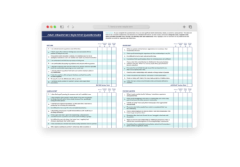Picture this: You’re home after a long day, sitting at the dinner table, hoping to reconnect with your partner. But each question you ask is met with a brief response, a shrug, or a sigh. The conversation fades, and a heavy silence settles in. It feels like there’s an invisible barrier between you, one that grows thicker with every attempt to bridge the gap.
This scenario might sound familiar—either from your own life or from the experiences of clients you work with. Emotional shutdown is a common challenge, and whether you’re the partner trying to instigate connection, or the partner feeling overwhelmed, it often leaves both partners feeling isolated and misunderstood. For therapists, these moments can be key indicators of deeper patterns of repression and shame that need to be addressed, and offer fertile ground for couples work that deepens mutual attunement and emotional understanding.
Often, the cycle of emotional shutdown is unintentionally reinforced by certain communication strategies—approaches we use in hopes of breaking the silence but that actually deepen the divide. We’ll follow our couple at the dinner table to see how these common patterns unfold in real time.
Share this Article:
Top Picks for You:
5 Common Mistakes That Deepen Emotional Shutdown
Feeling Rejected by Silence
The first misattunement in situations like the dinner table example often involves mistaking silence for indifference or dismissal. When you come home to a partner acting quiet, or you share something emotionally vulnerable, only to be met with silence or short replies, it’s easy to interpret that silence as a lack of interest or caring. This initial misinterpretation can trigger a series of reactions that escalate the emotional distance between partners.
When we feel ignored or rejected, our own defenses often begin to bristle. We might start to ruminate—why are they distracted, what are they thinking about, what did I do wrong?
Instead of recognizing that silence can stem from many reasons—like needing to unwind or process the day—this interpretation can lead to feelings of insecurity, and heightened emotional reactions.
But, if we recognize that moments of silence can often be a natural way of processing information, especially for partners with avoidant attachment adaptations, we can begin to see time, space, and quiet not as threats, but as prerequisites for connection.

Affirmations Without Awareness
Met with silence and perceived dismissal, it’s common for partners to move into a “fawn” response. While fight, flight, and freeze are better-known threat responses, fawning is also a natural reaction to nervous system overwhelm. When these unbearable feelings stem from emotional rejection, it’s especially common for anxious/ambivalent attachment styles to blame themselves, and to try and “make it right.”
Partners may begin offering compliments or positive reinforcement in the hope of drawing the avoidant partner into connection. However, these affirmations can often feel out of sync or inauthentic to someone with avoidant attachment. Because avoidant individuals often didn’t receive reliable validation in their past, they may also be inherently suspicious of compliments or see them as empty gestures.
Instead of fostering closeness, these well-meaning affirmations can be met with skepticism or dismissal, causing the avoidant partner to withdraw further. The result is a deeper sense of emotional disconnect and the potential for further shame—”I know they’re trying to be nice, so why am I feeling so closed off.”
These paradoxical responses can make the emotional terrain feel like a minefield, but there is a path out—typically involving patience, attunement, and genuine communication.
Demanding Immediate Vulnerability
Many of us crave more of that genuine connection in our lives. It’s common that our days may be filled with small talk or surface-level interactions—with colleagues, strangers, or folks we feel less vulnerable with. It’s natural then, that we long to find deeper connection at home.
However, the desire to break through the silence and reach a deeper level of communication can lead to pushing a partner to open up right away. We might start by sharing something emotionally challenging that we experienced in the day, in a hope that we can be held in some way, or that the sharing is reciprocated.
However, this pressure for immediate emotional openness can feel overwhelming, especially if one partner needs more time to decompress. It’s important to recognize that meaningful vulnerability often unfolds gradually. By allowing space and patience, partners can create a safe environment where they can gradually open up and share their feelings at their own pace.
This approach reduces pressure and allows both partners to feel more at ease, ultimately fostering a deeper and more authentic connection. By recognizing that vulnerability can’t be forced, couples can move toward a more balanced and understanding way of communicating.

Criticism and Judgment
By this point, our couple at the dinner table is likely feeling deeply misattuned. For the partner in shutdown, they might be wondering how they can escape the conversation, feeling overwhelmed by demands for presence that feels like too much.
For the “pursuing” partner, their attempts at connection—sharing our experiences or providing positive reinforcement—still haven’t been met with warmth or engagement. If it hadn’t already, the disconnection might now feel personal
From here, it’s common to voice our concerns directly. We might say things like, “Why can’t you just open up?” or “You’re being distant again.” While these comments might be well-intentioned to prompt a reaction, they’re more likely to be read as criticism and judgment. Unsurprisingly, this can activate feelings of shame or rejection in the other person, causing them to withdraw even further.
This cycle of criticism and withdrawal creates a reinforcing loop, deepening the emotional divide. Instead of fostering openness, it reinforces the very barriers we’re trying to break down.
Emotional Flooding
From here, it likely feels for the anxious/ambivalent partner, that they’ve tried everything. In these moments, a surge of intense emotion—anger, frustration, or desperation—can feel like a last-ditch effort to shake their partner out of withdrawal. The hope is that by amplifying their own emotional intensity, they can prompt their partner to re-engage.
Unfortunately, this tactic often has the opposite effect. Instead of “waking up,” or bringing their partner closer, it can cause the avoidant partner to shut down with even more rigidity. Imagine—if the threat that their avoidant adaptation was detecting from a simple act of sharing was feeling like too much—an emotional outburst confirms their worst fears. They may feel vindicated in their position, which for avoidantly attached folks, tend to sound like “emotions are too much,” “vulnerability isn’t safe,” and “connection isn’t worth the danger.” This keeps them locked in a self-confirming bind, where even the prospect of stepping into connection has led to emotional overwhelm.

Creating Attuned Connection
The communication patterns we’ve outlined here are rarely malicious. They often arise from a deep longing for closeness and safety. But when one partner tends to shut down and the other seeks connection more urgently, these cycles can entrench disconnection instead of resolving it.
The path toward repair and reconnection asks something of both partners—but not that either become someone they’re not. For those with more avoidant tendencies, the work often involves building a greater tolerance for emotional presence and recognizing that vulnerability is not inherently dangerous. It means forming new internal associations—ones where intimacy and safety can coexist.
For those with more anxious ambivalent styles, the growth edge often lies in learning to tolerate uncertainty without rushing to close the gap, and in respecting a partner’s need for space without interpreting it as rejection. This may mean practicing emotional regulation without suppressing the need for closeness.
But let’s be clear: connection still requires reaching. Repair still requires vulnerability. And change still requires safety. Anxious partners shouldn’t stop expressing need just to avoid overwhelming the other. Avoidant partners shouldn’t be expected to bypass their nervous system’s rhythms to meet someone else’s timeline. Instead, both people are invited to bring awareness and flexibility to how they express and respond to those needs.
When partners learn to understand each other’s attachment patterns, nervous systems, and emotional pacing, they can co-create a space where both connection and autonomy are honored. Over time, the very dynamics that once created rupture can become the foundation for deeper trust, mutual regulation, and resilient intimacy.





Ready to Begin Your Healing Journey?
Browse on-demand courses and begin learning from top experts today!


